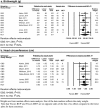Buprenorphine compared with methadone to treat pregnant women with opioid use disorder: a systematic review and meta-analysis of safety in the mother, fetus and child
- PMID: 27223595
- PMCID: PMC5129590
- DOI: 10.1111/add.13462
Buprenorphine compared with methadone to treat pregnant women with opioid use disorder: a systematic review and meta-analysis of safety in the mother, fetus and child
Abstract
Aims: To assess the safety of buprenorphine compared with methadone to treat pregnant women with opioid use disorder.
Methods: We searched PubMed, Embase and the Cochrane Library from inception to February 2015 for randomized controlled trials (RCT) and observational cohort studies (OBS) that compared buprenorphine with methadone for treating opioid-dependent pregnant women. Two reviewers assessed independently the titles and abstracts of all search results and full texts of potentially eligible studies reporting original data for maternal/fetal/infant death, preterm birth, fetal growth outcomes, fetal/congenital anomalies, fetal/child neurodevelopment and/or maternal adverse events. We ascertained each study's risk of bias using validated instruments and assessed the strength of evidence for each outcome using established methods. We computed effect sizes using random-effects models for each outcome with two or more studies.
Results: Three RCTs (n = 223) and 15 cohort OBSs (n = 1923) met inclusion criteria. In meta-analyses using unadjusted data and methadone as comparator, buprenorphine was associated with lower risk of preterm birth [RCT risk ratio (RR) = 0.40, 95% confidence interval (CI) = 0.18, 0.91; OBS RR = 0.67, 95% CI = 0.50, 0.90], greater birth weight [RCT weighted mean difference (WMD) = 277 g, 95% CI = 104, 450; OBS WMD = 265 g, 95% CI = 196, 335] and larger head circumference [RCT WMD = 0.90 cm, 95% CI = 0.14, 1.66; OBS WMD = 0.68 cm, 95% CI = 0.41, 0.94]. No treatment differences were observed for spontaneous fetal death, fetal/congenital anomalies and other fetal growth measures, although the power to detect such differences may be inadequate due to small sample sizes.
Conclusions: Moderately strong evidence indicates lower risk of preterm birth, greater birth weight and larger head circumference with buprenorphine treatment of maternal opioid use disorder during pregnancy compared with methadone treatment, and no greater harms.
Keywords: Buprenorphine; dependence; fetus; harm; methadone; opioid use disorder; pregnancy.
© 2016 The Authors. Addiction published by John Wiley & Sons Ltd on behalf of Society for the Study of Addiction.
Figures





Comment in
-
Response to Smith and Brogly et al. commentaries on Zedler et al.Addiction. 2016 Dec;111(12):2131-2133. doi: 10.1111/add.13608. Addiction. 2016. PMID: 28075535 No abstract available.
-
The comparative safety of buprenorphine versus methadone in pregnancy-what about confounding?Addiction. 2016 Dec;111(12):2130-2131. doi: 10.1111/add.13551. Addiction. 2016. PMID: 28075537 Free PMC article.
-
Zero is an important number.Addiction. 2016 Dec;111(12):2129-2130. doi: 10.1111/add.13529. Addiction. 2016. PMID: 28075540 No abstract available.
References
-
- Substance Abuse and Mental Health Services Administration (SAMHSA) . Results from the 2010 National Survey on Drug Use and Health: Summary of National Findings. Rockville, MD: SAMHSA, 2011 Contract No.: HHS Publication no. (SMA) 11–4658.
-
- Maeda A., Bateman B. T., Clancy C. R., Creanga A. A., Leffert L. R. Opioid abuse and dependence during pregnancy: temporal trends and obstetrical outcomes. Anesthesiology 2014; 121: 1158–65. - PubMed
-
- Gyarmathy V. A., Giraudon I., Hedrich D., Montanari L., Guarita B., Wiessing L. Drug use and pregnancy—challenges for public health. Euro Surveill 2009; 14: 33–36. - PubMed
-
- World Health Organization (WHO) . Guidelines for identification and management of substance use and substance use disorders in pregnancy 2014. Available at: http://www.who.int/substance_abuse/publications/pregnancy_guidelines/en/ (accessed 1 September 2015) (Archived by WebCite® at http://www.webcitation.org/6gOmIM2FB). - PubMed
Publication types
MeSH terms
Substances
LinkOut - more resources
Full Text Sources
Other Literature Sources
Medical
Miscellaneous

